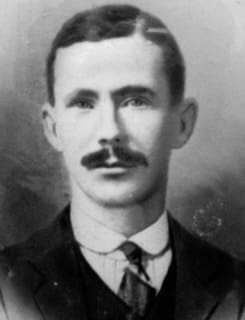A fallen son of Ireland
 Captain Patrick White was a former carpenter who became active in the Irish War of Independence. Following arrest, he was sent to Spike Island on the 12th of April 1921, from Cork Male Gaol. White was in his mid-thirties and a captain in the Meelick Company of the East Clare Brigade of the IRA, having been involved with the Irish Volunteers since 1914. He was among a group attempting to meet the gun-running ship the Aud in 1916, only to hear of its capture and later sinking close to Spike Island. It was after participating in an attack on Crown Forces at Cartloe, Clare, in which two RIC officers were killed, that White was apprehended, along with his friend Thomas Ringrose. Both men suffered the trauma of being used as human shields on British convoys, to prevent their fellow IRA members from attacking the vehicles for fear of injuring them. It was a relief to both rebels to be taken off the mainland to Spike, White reportedly saying to his friend Ringrose ‘We are safe now’.
Captain Patrick White was a former carpenter who became active in the Irish War of Independence. Following arrest, he was sent to Spike Island on the 12th of April 1921, from Cork Male Gaol. White was in his mid-thirties and a captain in the Meelick Company of the East Clare Brigade of the IRA, having been involved with the Irish Volunteers since 1914. He was among a group attempting to meet the gun-running ship the Aud in 1916, only to hear of its capture and later sinking close to Spike Island. It was after participating in an attack on Crown Forces at Cartloe, Clare, in which two RIC officers were killed, that White was apprehended, along with his friend Thomas Ringrose. Both men suffered the trauma of being used as human shields on British convoys, to prevent their fellow IRA members from attacking the vehicles for fear of injuring them. It was a relief to both rebels to be taken off the mainland to Spike, White reportedly saying to his friend Ringrose ‘We are safe now’.
Shot while playing hurling

There was nothing unusual about the day, or the playing of sport in the prison compound, which was separated from the parade ground and patrolling armed guards by a 15 foot high barbed wire fence. Games typically took place in the late afternoon, ahead of the 8pm order to head indoors. Just before 6pm that evening the men knocked the ball among them until it went astray, rolling under the wire towards the parade ground where it stopped. Patrick White was closest and he ran to retrieve the ball, reaching to free it, when a sentry standing nearby raised his gun, pulled the trigger, and shot Patrick White. The shot rang around the fortress, startling birds and stunning the men who had been playing hurling with Patrick. After a moment of disbelief Patrick’s fellow internees rushed to his side. Prison guards raced to the location of the sentry, to ascertain what had happened. The internees saw the camp commandant quiz the soldier and insist he unload his weapon, before he was removed. The camps military doctor came to begin first aid, but the equally sudden arrival of the prison chaplain, Father Callanan, was an ominous sign. Patrick White’s comrades stood back and prayed, fearing the worst, and those fears seemed realised when the chaplain began administering the last rites. White was lifted into a stretcher and carried to the prison hospital where the medical attendant fought to save him, but the bullet had done its work. Patrick White died of at approximately 7.20pm, murdered while imprisoned on Spike Island Cork.
Home to County Clare
 White’s body was taken to the A block, where his countrymen held a vigil guard of honour overnight, not leaving him alone for a second. Hut one, A block, Spike Island, was a place of pain and suffering that night, as the soldiers of Ireland stood over their fallen friend, distraught and mute in disbelief. The following morning at 8.30am the cold body of Patrick White was lifted to the prison chapel, where a mass was held in solemn silence. When it ended his friends lifted the body back to hut one where it remained for two more days, while arrangements were made. On June 03rd, three days after the shooting, the body of Patrick White, now in a simple timber coffin, was brought once again to the prison chapel for a requiem Mass, before being carried by his fellow prisoners from the chapel towards the pier. Every single one of the prisoners and internees well enough to be present were there, lining the parade ground in tribute as the coffin passed. A select few of his fellow internees were permitted to carry his coffin beneath the forts entrance, out beyond the walls of the prison that confined him to catch sight of the mainland he was deprived of. An Ireland he had fought to free. On arrival to the pier they loaded his coffin on to a waiting ship, and turned to march back to captivity, looking over their shoulders as Patrick White, friend and fellow Republican, was taken on his last journey. His body was transported to Cobh where it was sent by train to his hometown of Meelick, County Clare, to be buried by his family. They might have feared, but could never have foreseen, that the next time they saw their relation following his arrest, would be at his burial.
White’s body was taken to the A block, where his countrymen held a vigil guard of honour overnight, not leaving him alone for a second. Hut one, A block, Spike Island, was a place of pain and suffering that night, as the soldiers of Ireland stood over their fallen friend, distraught and mute in disbelief. The following morning at 8.30am the cold body of Patrick White was lifted to the prison chapel, where a mass was held in solemn silence. When it ended his friends lifted the body back to hut one where it remained for two more days, while arrangements were made. On June 03rd, three days after the shooting, the body of Patrick White, now in a simple timber coffin, was brought once again to the prison chapel for a requiem Mass, before being carried by his fellow prisoners from the chapel towards the pier. Every single one of the prisoners and internees well enough to be present were there, lining the parade ground in tribute as the coffin passed. A select few of his fellow internees were permitted to carry his coffin beneath the forts entrance, out beyond the walls of the prison that confined him to catch sight of the mainland he was deprived of. An Ireland he had fought to free. On arrival to the pier they loaded his coffin on to a waiting ship, and turned to march back to captivity, looking over their shoulders as Patrick White, friend and fellow Republican, was taken on his last journey. His body was transported to Cobh where it was sent by train to his hometown of Meelick, County Clare, to be buried by his family. They might have feared, but could never have foreseen, that the next time they saw their relation following his arrest, would be at his burial.
The IRA internees and prisoners made their way to their huts that evening in low, angry mood. They were aware that an investigation was being held on that very day, 03rd June, expedited in the hope that some form of action would reduce the risk of reprisal. The very first person called to speak at the Military Court of inquiry was the only person who truly mattered – Private Whitehead, Second Battalion, Kings Own Scottish Borderers, who had been standing at number two sentry post when Patrick White approached the wire, and he shot White dead. His words were calculated and simple; “My orders were to fire at any internee tampering with the wire. The deceased was stretching out his hand through the wire to get a ball. In accordance with my orders I fired at him and hit him”. His defence stated that sentries had received written orders to fire without warning on a prisoner if they interfered with the wire. With such a clear instruction and a calculated and calm claim of innocence from the soldier, the inquiry concluded; “That the deceased was himself to blame, in as much as he tampered with the wire surrounding the compound in defiance of orders”.
It was an unfair verdict on White, and its true causes were clear to the IRA. There had been a serious assault on British soldiers in the nearby town of Youghal, in East Cork the morning of the shooting. A roadside bomb planted by the IRA was detonated as the band of the Hampshire Regiment passed, seriously injuring twenty and eventually killing seven. The attack incensed the armed forces, in particular the use of a roadside bomb, and when the news reached the British armed forces tasked with guarding Spike Island’s Republican prisoners and internees, the outcome seems clear. Patrick White was murdered in cold blood in reprisal.
It can never be proven, and no justice was ever served. The young Captain is remembered on the island for his service, and paying the ultimate price, in the fight for Irish freedom.

